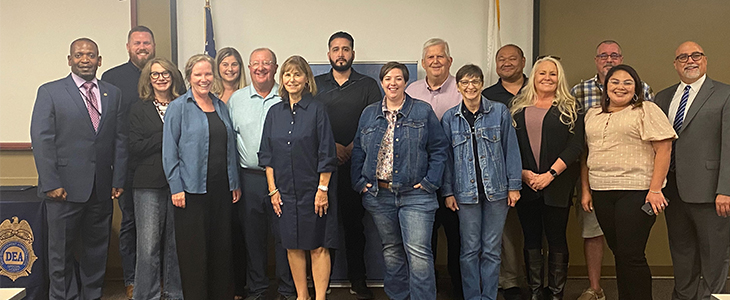
As a seasoned anti-money laundering (AML) expert specializing in high-risk sectors, I have witnessed firsthand the sophisticated money laundering methods employed by criminals to profit from their illicit activities. However, my recent experience at the Drug Enforcement Administration (DEA) St. Louis Division, Kansas City District Office Citizens Academy, provided me with an invaluable perspective that extends beyond the confines of financial crimes compliance. The DEA Citizens Academy is a key component of Operation Engage, a comprehensive approach to combating the drug epidemic through prevention strategies, creating awareness and encouraging collaboration with local community leaders.
The DEA Citizens Academy Program
Over an intensive five-week program, a select group of community leaders were made privy to briefings that revealed the magnitude and complexity of drug threats that lurk within our communities. Additional hands-on training brought the day-to-day challenges and triumphs of the DEA’s dedicated personnel to life. This firsthand exposure was enlightening and, at times, sobering, highlighting the relentless efforts needed to safeguard our society from the scourge of drugs.
The academy commenced with a comprehensive overview of the DEA’s mission, ingraining in us the gravity and breadth of their mandate. We delved into the agency’s storied past, tracing its evolution in response to the changing dynamics of drug trafficking and abuse. We were also granted the rare opportunity to view seized evidence from drug busts and raids. The evidence rooms resembled a museum: rows upon rows of shelves and boxes securely housing everything from narcotics to cash counting machines to high-powered firearms, each meticulously tagged and cataloged. Each piece of evidence was a symbol of interrupted supply chains, foiled plans and, ultimately, lives saved from the clutches of addiction. The DEA’s meticulous post-operation processes are critical in ensuring their evidence can lead to successful prosecutions. It was an introduction like no other, culminating in a moving tribute to fallen DEA agents, whose sacrifices serve as a constant reminder of the dangers faced in the line of duty.
In subsequent weeks, we engaged with a highly skilled drug-detection K9 unit. The bond between handlers and their canine partners was extraordinary. The dogs’ acute senses and unwavering discipline underscored their critical role in detection and prevention efforts. The group was also immersed in the tactical aspects of DEA operations, including shooting techniques and raid planning and execution strategies. The hands-on experience at the firing range and mock raid scenarios were exhilarating and educational, emphasizing the importance of precision, control and teamwork in high-stakes situations.
A Look Into the DEA’s Operations
Our exploration into DEA operations continued with an in-depth look at surveillance and undercover operations. From state-of-the-art equipment to the vehicles that often serve as mobile observation posts, we were given a rare glimpse into the technological arsenal at the DEA’s disposal. We were then introduced to undercover agents who were trained to blend seamlessly into the criminal underworld, often taking on false identities and backstories that withstand the scrutiny of the drug cartels and criminal organizations they infiltrate. These operations are not merely exercises in deception but are meticulously planned missions that can last for months or even years, gathering crucial evidence needed to dismantle drug operations from the inside.
During these operations, agents might pose as buyers, sellers or middlemen, engaging in a high-stakes game of trust and betrayal where one misstep could jeopardize not only the mission but their lives. The agents are supported by a network of surveillance, informants and communication intercepts, ensuring they are never truly alone in their covert roles. The Citizens Academy provided us with a snapshot of the intense training, psychological resilience and operational acumen required to execute such operations, emphasizing the agents’ dedication and the significant risks they undertake to keep illegal substances off the streets.
The academy also highlighted the DEA’s global reach: With 92 offices in 69 countries, the DEA is the single point of contact for the U.S. in foreign countries for drug investigations. Their international presence is a pivotal aspect of their mission, reflecting the global nature of drug trafficking and its implications for national and international security. By establishing foreign offices in key locations around the world, the DEA works tirelessly to dismantle the vast networks that facilitate drug production, trafficking and distribution on a global scale. These international efforts are supported by strong partnerships with local law enforcement (LE) agencies, enhancing the capacity to conduct complex operations and share intelligence critical to disrupting drug trafficking routes.
Global Efforts and Combating Financial Crimes
The DEA also provides training and support to its foreign counterparts, aiming to foster an environment of mutual respect and cooperation that transcends national boundaries. By helping to reduce the power and influence of drug cartels, the DEA aids in diminishing the corruption and violence that often accompany the drug trade, thereby advancing U.S. foreign policy objectives related to human rights and international development. The international arm of the DEA is yet another testament to the agency’s commitment to a comprehensive approach against the drug epidemic—a fight that knows no borders.
A particularly harrowing week was dedicated to the fentanyl crisis, examining its origins, the devastating impact it has nationwide, and the multifaceted approach the DEA employs to combat this epidemic. This deep dive into the fentanyl crisis highlighted the complexities of interdiction, the importance of public education, and the urgent need for collaboration across all sectors to address this pervasive threat that claims the lives of almost 300 Americans daily.
Throughout the academy, I often found myself drawing parallels between the DEA’s relentless pursuit of justice and the meticulous nature of AML efforts in the financial sector. Witnessing firsthand the DEA’s multifaceted approach—from boots-on-the-ground operations to advanced data analysis—underscored the point that our work in AML is not in isolation but is interconnected with a larger, collaborative effort to uphold the integrity of the financial system.
Understanding the front-line battles against drug trafficking also emphasized the critical role of AML; every attempt to identify and report suspicious activities directly impacts the DEA’s ability to trace and dismantle the financial lifelines fueling the drug trade. Learning about the devastating toll that drug trafficking takes on individuals and communities deepened my sense of responsibility and my appreciation of our role in the broader drug trafficking campaign.
Furthermore, interactive sessions with DEA agents revealed the critical need for precise and actionable intelligence from financial institutions (FIs). Discussions about the DEA’s operational challenges showed that timely and detailed reporting from banks can significantly enhance the effectiveness of LE interventions. This holistic view reiterated the significance of cross-sector collaboration and reinforced my conviction that vigilance in AML practices is not just a regulatory requirement but a societal imperative.
As the program drew to a close, we reflected on the immersive experience and the wealth of knowledge we had acquired. For those of us in the financial sector, it enabled us to grasp the full scope of the drug epidemic, including the financial tentacles that extend into our realm. It further sharpened our ability to detect and counteract the sophisticated money laundering tactics at the heart of the drug trade.
Conclusion
The DEA St. Louis Division, Kansas City District Office Citizens Academy class graduated on September 27, 2023, marking the beginning of a strengthened partnership between local community leaders and the DEA. The graduation ceremony was not merely a formality but a pledge to carry the lessons learned forward into our respective fields.
In conclusion, the DEA Citizens Academy is a remarkable platform that aligns local leaders with LE efforts, enlightening us on the multifaceted nature of drug enforcement and the critical role we play in this ecosystem. We are now better advocates, equipped to make an impact in our professions and contribute more effectively to the eradication of the drug epidemic. This initiative by the DEA is not just about education; it is an invitation to rise to the occasion and foster a genuine partnership in the quest to keep our families and communities safe. The intensity of the program was matched only by the dedication of those who led us through it. As I reflect on the experiences and insights gained, I am reinvigorated with a sense of purpose and commitment to ensuring that our FIs stand as guardians of our nation’s financial system and as safeguards against the financial mechanisms that fuel drug trafficking and other crimes. Together, we can and will make a tangible difference.
John Calderon, CAMS, executive vice president, chief compliance officer, BSA/AML officer, Bison State Bank, ![]()










